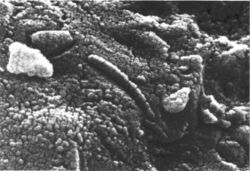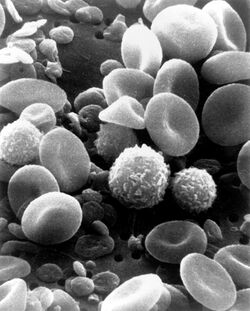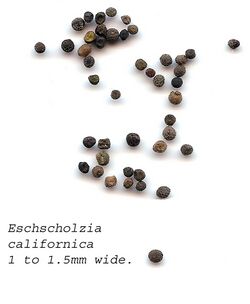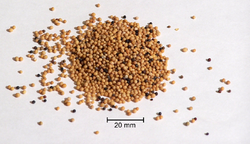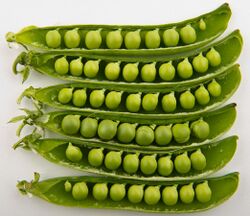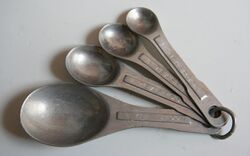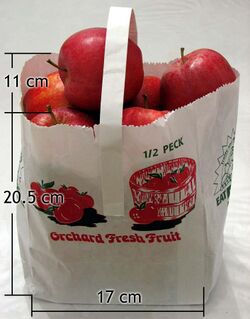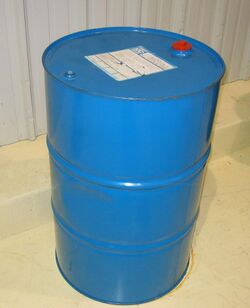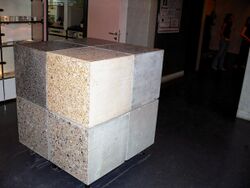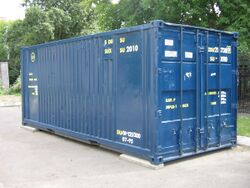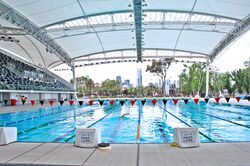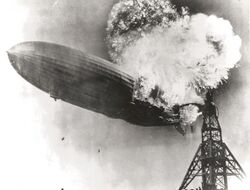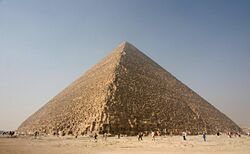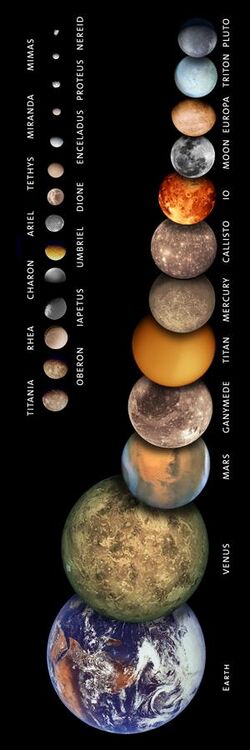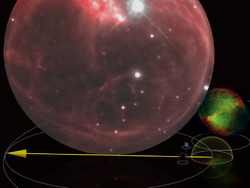Orders of magnitude (volume)
 From HandWiki - Reading time: 10 min
From HandWiki - Reading time: 10 min
Short description: List of objects and units
The table lists various objects and units by the order of magnitude of their volume.

The globular cluster Messier 5 at upper left with about 2 million cubic light years (1.7×1054 m3) dwarfs the much smaller Bubble Nebula at lower right.
Sub-microscopic
| Volume (m3) | Example |
|---|---|
| 4.22419×10−105 | The Planck volume |
| 1×10−90 | One cubic quectometre |
| 1×10−81 | One cubic rontometre |
| 1×10−72 | One cubic yoctometre |
| 1×10−63 | One cubic zeptometre |
| 1×10−54 | One cubic attometre |
| 1×10−45 | One cubic femtometre |
| ~2.82×10−45 | Volume of a proton |
| ~9.4×10−44 | Classical volume of an electron |
| 1×10−36 | One cubic picometre |
| 1×10−33 | One quectolitre |
| 1×10−30 | One cubic ångström or one rontolitre |
| 7.23×10−30 | Volume enclosed by the Van der Waals radius of a hydrogen atom |
| 3.936×10−29 | van der Waals volume of a helium atom |
| 1.91×10−29 | volume enclosed by the van der Waals radius of a gold atom |
| 3.75×10−29 | van der Waals volume of a H2 molecule |
| 5.29×10−29 | van der Waals volume of a O2 molecule |
| 1×10−27 | One cubic nanometre or one yoctolitre |
| 1×10−24 | One zeptolitre |
| 5×10−23 | Typical volume of structures on the Martian meteorite ALH84001 |
| 1×10−21 | One attolitre |
| 4×10−21 | Volume of hypothesised nanobacteria |
| 5×10−21 | Volume of a typical virus |
Microscopic
| Volume (m3) | Example |
|---|---|
| 1×10−18 | One cubic micrometre or one femtolitre |
| 9×10−18 | Average volume of a platelet |
| 9×10−17 | Normal volume of a human red blood cell |
| 2×10−16 | Average volume of a lymphocyte |
| 3.3×10−16 | Mean volume of a neutrophil granulocyte |
| 4.2×10−16 | Volume of an average monocyte |
| 1×10−15 | One picolitre |
| 2–9×10−15 | One drop from a high resolution colour inkjet printer |
| 1.3×10−13 | a very fine grain of sand (0.063 mm diameter, 3 micrograms) |
| 1×10−12 | One nanolitre |
| 6.2×10−11 | A medium grain of sand (0.5 mm diameter, 1.5 milligrams) |
| 5×10−10 | Volume of a poppy seed of 1-millimetre diameter[1] |
| 1×10−9 | One cubic millimetre or one microlitre |
| 4×10−9 | Volume of a mustard seed of 2-millimetre diameter |
| 2×10−8 | Volume of a small grain of rice 2 mm wide by 5 mm long |
Human measures
| Volume (m3) | Example |
|---|---|
| 5.92×10−8 | One imperial minim |
| 6.16×10−8 | One US minim |
| 7×10−8 | Volume of a large grain of rice 3 mm wide by 12 mm long |
| 2×10−7 | Average volume of a pea |
| 1×10−6 | One cubic centimetre or one millilitre |
| 1.18×10−6 | One imperial fluid scruple |
| 1.23×10−6 | One US fluid scruple |
| 1.80×10−6 | One sai |
| 3.55×10−6 | One imperial fluid drachm |
| 3.70×10−6 | One US fluid dram |
| 3–5×10−6 | Average human ejaculation[2] |
| 3.55–5×10−6 | One teaspoon |
| 1.14×10−5 | One ligula |
| 1.42–2.0×10−5 | One tablespoon |
| 1.639×10−5 | One cubic inch |
| 1.80×10−5 | One shaku |
| 2.84×10−5 | One imperial fluid ounce |
| 2.96×10−5 | One US fluid ounce |
| 3.5×10−5 | Average amount of blood lost by a woman during menstruation |
| 4.5×10−5 | One cyathus |
| 6.8×10−5 | One acetabulum |
| 1×10−4 | Maximum volume of non-exempt liquids, gels, and aerosols allowed in a U.S. air traveler's carry-on luggage |
| 1.18×10−4 | One US gill |
| 1.36×10−4 | One quartarius |
| 1.42×10−4 | One imperial gill |
| 1.80×10−4 | One gō (a common size for serving sake) |
| 2.73×10−4 | one Roman hemina or cotyla |
| 3.3–3.75×10−4 | Volume of stubby or steinie of beer (Europe–330 mL, Canada–341 mL, Japan–350 mL, US–355 mL, Australia–375 mL) |
| 4×10−4 | Rough volume of the human urinary bladder |
| 4.73×10−4 | One US liquid pint |
| 5.46×10−4 | One sextarius |
| 5.51×10−4 | One US dry pint |
| 5.68×10−4 | One imperial pint |
| 7.5×10−4 | The most common volume for wine and liquor bottles, also the size of an Australian long neck of beer; sometimes called a 'fifth' in the United States for its approximation to the once-common one-fifth-gallon bottle |
| 9.46×10−4 | One US liquid quart |
| 1×10−3 | One cubic decimetre or one litre |
| 1.000028×10−3 | Volume of 1 kilogram of distilled water (at the temperature of maximum density (3.98 °C or 39.16 °F) and standard atmospheric pressure (101.325 kPa)) |
| 1.10×10−3 | One US dry quart |
| 1.14×10−3 | One imperial quart |
| 1.0–8.2×10−3 | Typical range of automobile engine displacements |
| 1.4×10−3 | Human brain cavity |
| 1.80×10−3 | One shō (formerly a common sake-bottle size) |
| 3.8×10−3 | One US liquid gallon |
| 4.36×10−3 | One semimodius |
| 4.40×10−3 | One US dry gallon |
| 4.5×10−3 | One imperial gallon |
| 5×10−3 | Approximate volume of the blood in one adult human |
| 6×10−3 | Average total volume of the lungs of a male human |
| 8.81×10−3 | One US peck |
| 9.09×10−3 | One imperial peck |
| 1.31×10−2 | One urna |
| 1.80×10−2 | One to |
| 1.85–3.6×10−2 | One Ancient Greek amphora |
| 2.62×10−2 | One Roman amphora |
| 3.4×10−2 | One French amphora |
| 2.83×10−2 | One cubic foot |
| 3.52×10−2 | One US bushel |
| 3.64×10−2 | One imperial bushel |
| 3.7–4.2×10−2 | One firkin |
| 6.0×10−2 | Gasoline fuel tank in a car (Volvo 240)[3] |
| 6.8–6.9×10−2 | One rundlet |
| 7.1×10−2 | Average volume of an adult human |
| 7.4–8.3×10−2 | One kilderkin |
| 9.55×10−2 | One US barrel for cranberries |
| 1.16×10−1 | One US dry barrel |
| 1.17×10−1 | One US beer barrel, 31 US gallons |
| 1.19×10−1 | One US fluid barrel (apart from oil or beer), 31.5 US gallons |
| 1.59×10−1 | One oil barrel, 42 US gallons, about one tierce (158–160 L) |
| 1.64×10−1 | One imperial barrel, 36 imperial gallons |
| 1.80×10−1 | One koku |
| 2×10−1 | Standard drum size used for shipping bulk cargo |
| 2.2–2.5×10−1 | One hogshead |
| 3.1–3.2×10−1 | One puncheon or tertian |
| 4.7–4.9×10−1 | One butt (an old unit for beer and wine) |
| 5.24×10−1 | One culeus |
| 7.65×10−1 | One cubic yard |
| 9.5–9.8×10−1 | One tun (an old unit for beer and wine) |
| 1×100 | One cubic metre, one kilolitre or one stère—volume of a large domestic fridge-freezer (external dimensions) |
| 3.85×101 | External volume of a standard 20-foot ("TEU") cargo container, which has a capacity of 33.1 cubic metres |
| 7.7×101 | External volume of a standard 40-foot ("FEU") cargo container, which has a capacity of 67.5 cubic metres |
Terrestrial
| Volume (m3) | Example |
|---|---|
| 1.05×102 | Volume of a rear-engine Leyland Titan London double-decker bus |
| 1.49×102 | Volume of any A Division New York City Subway car |
| 1×103 m3 (35,000 cu ft; 1.0×10−6 km3) | One cubic decametre or one megalitre |
| 1.233×103 | One acre-foot |
| 2.5×103 | Volume of an Olympic size swimming pool of minimal depth (50 m × 25 m × 2 m). |
| 3.054×103 | Volume of each of the nine spheres of the Atomium in Brussels |
| 1.13×104 | Gas volume in the first zeppelin LZ 1 |
| 1.1866×104 | Amount of concrete in Trbovlje Chimney |
| 1.56×104 | Quebec's 2001 output of maple syrup |
| 5.0×104 | Typical volume of a large gasometer |
| 8.5–9.9×104 | Volume of the Royal Albert Hall auditorium[4] |
| 1.84×105 | Volume of gas in the USS Macon (ZRS-5) zeppelin |
| 2.11890×105 | Volume of gas in the Hindenburg zeppelin |
| 6.50×105 | Volume of crude oil that can be carried aboard the Knock Nevis supertanker |
| 9.66×105 | Volume of Taipei 101's gross floor space[5] |
| 1×106 m3 (1,300,000 cu yd; 0.0010 km3) | One cubic hectometre, one gigalitre or one kilostère |
| 1.4×106 | Volume the 1910 Lakeview Gusher oil spilt (the biggest oil gusher in US history) |
| 1.5644×106 | Volume of concrete in the Panama Canal Locks |
| 2.6006×106 | Volume of stone in the Great Pyramid of Giza |
| 3×106 | Approximately amount of mud and clay that slid into the South Nation River valley as a landslide on 20 June 1993 |
| 3.33×106 | Volume of concrete in Hoover Dam |
| 3.664883×106 | Volume of the NASA's Vehicle Assembly Building |
| 8×106 | Volume of chalk excavated in the construction of the Channel Tunnel |
| 1×107 | Volume of Chagan Lake, artificial lake created by nuclear explosion |
| 1.7×107 | Volume of material in the Gatun Dam, completed in 1913 |
| 2.8×107 | Volume of concrete in the Three Gorges Dam, the world's largest concrete structure |
| 4.3×107 | Volume of Aswan Dam |
| 9×107 | Volume of gas required per day by India in 2005 |
| 1.01×108 | Volume of the Grimsel reservoir |
| 1.73×108 | Volume of Lake Baldegg, Switzerland |
| 2.05×108 | Volume of material excavated in the construction of the Panama Canal |
| 2.2×108 | Volume of Lac de la Gruyère, Switzerland |
| 2.85×108 | Volume of Lake Halwill, Switzerland |
| 3.20–3.35×108 | Volume of the Great Wall of China |
| 3–5×108 | Volume of all humans alive on the planet (based on an average mass of 40–70 kg per human) |
| 4×108 | Predicted volume of natural gas required per day by India in 2025 |
| 5×108 | One sydharb—volume of Sydney Harbour, Australia[6] |
| 6.93×108 | Volume of Lake Murten, Switzerland |
| 1×109 m3 (1.3×109 cu yd; 1.0 km3) | One cubic kilometre or one teralitre |
| 1.2×109 | Approximate volume of rock ejected during the 1980 eruption of Mount St. Helens |
| 1.3×109 | volume of Lake Biel, Switzerland |
| 2.5×109 | volume of Lake Walen, Switzerland |
| 3.2×109 | volume of Lake Zug |
| 3.9×109 | Volume of Lake Zürich |
| 4.168×109 | One cubic mile |
| 5×109 | Volume of crude oil consumed by the world in a year |
| 5.17×109 | volume of Lake Brienz |
| 5.2×109 | Volume of the artificial Gatun Lake (Panama Canal) |
| 6.5×109 | Volume of Lake Thun |
| 6.5×109 | volume of Lake Lugano |
| 1×1010 | Estimated volume of rock ejected during the 1991 eruption of Mount Pinatubo |
| 1.4×1010 | volume of Lake Neuchâtel |
| 1.45×1010 | Volume of Lake Lucerne |
| 3.52×1010 | Volume of Lake Mead, the reservoir of the Hoover Dam |
| 3.7×1010 | Volume of Lago Maggiore |
| 5.5×1010 | Volume of Lake Constance |
| 8.89×1010 | Volume of Lake Geneva |
| 1×1011 | Estimated volume of rock exploded in eruption of Mount Tambora volcano on 12 April 1815 |
| 1.33×1011 | Volume of Lake Nasser |
| 1.44×1011 | Volume of Fedchenko Glacier and its tributaries |
| 2×1011 | Estimated volume of the annual net inflow of seawater to the Black Sea (from the Mediterranean Sea via the Bosporus) |
| 2.8×1011 | Volume of Lake Onega |
| ~3×1011 | Volume of crude oil on Earth |
| 3.2×1011 | Estimated volume of the annual inflow of freshwater to the Black Sea |
| 4.84×1011 | Volume of Lake Erie |
| 8.37×1011 | Volume of Lake Ladoga |
| 1×1012 m3 (1.3×1012 cu yd; 1,000 km3) | One petalitre |
| 1.1×1012 | Volume of the Aral Sea in 1960 |
| 2.76×1012 | Volume of Lake Victoria |
| 2.8×1012 | Volume of magma erupted by the Toba supervolcano 74000 years ago |
| 4.918×1012 | Volume of Lake Michigan |
| 5×1012 | Volume of the Fish Canyon Tuff erupted by the La Garita Caldera |
| 5.5×1012 | Volume of the asteroid 433 Eros |
| 1.2232×1013 | Volume of Lake Superior |
| 1.84×1013 | Volume of Lake Tanganyika |
| 2.36×1013 | Volume of Lake Baikal |
| 5.5×1014 | Volume of the Black Sea |
| 1×1015 | One exalitre |
| 1×1015 m3 (1.3×1015 cu yd; 1,000,000 km3) | Volume of the Mariana Trench in the Pacific Ocean, which contains the deepest point on the Earth's surface |
| 2.6×1015 | Volume of Greenland ice cap |
| 3.7×1015 | Volume of the Mediterranean Sea |
| 1.54×1016 | Volume of water contained in the rings of Saturn (rough estimate) |
| 3×1016 | Volume of water contained in the Antarctic ice sheet (rough estimate) |
| 3×1017 | Volume of the Atlantic Ocean and volume of the Indian Ocean (rough estimates) |
| 4.5×1017 | Volume of Ceres |
| 1×1018 | One cubic megametre or one zettalitre—volume of the Pacific Ocean (rough estimate) |
| 1.335×1018 | Volume of all oceans on Earth |
Astronomical
| Volume (m3) | Example |
|---|---|
| 3×1018 | Estimated volume of Europa's oceans |
| 6.4×1018 | Volume of Pluto |
| 2.2×1019 | Volume of the Moon |
| 6.1×1019 | Volume of planet Mercury |
| 1.6×1020 | Volume of planet Mars |
| 9.28×1020 | Volume of planet Venus |
| 1×1021 | One yottalitre |
| 1.08×1021 | Volume of planet Earth |
| 2.25×1021 | Volume of all the rocky planets in the Solar System |
| 6.38×1022 | Volume of planet Neptune |
| 7.02×1022 | Volume of planet Uranus |
| 9.23×1023 | Volume of planet Saturn |
| 1×1024 | One ronnalitre |
| 1.53×1024 | Volume of planet Jupiter |
| 2.59×1024 | Total volume of all the planets in the Solar System |
| 1×1027 | One cubic gigametre or one quettalitre |
| 1.41×1027 | Volume of the Sun |
| ~1×1030 | volume of Alcyone, brightest star in the Pleiades[7] |
| ~1.7×1031 | Volume of Arcturus, brightest star in Boötes[8] |
| 3.4×1032 | Volume of Rigel, the brightest star in Orion[9] |
| ~5×1032 | Volume of a red giant the same mass as the Sun |
| 1.4×1033 | Volume of γ Crucis, a red giant in Crux[10][11] |
| ~1×1034 | Volume of Deneb, a white supergiant in Cygnus[12] |
| 6.4×1034 | Volume of η Carinae, a white supergiant in Cygnus[12] |
| 1.3×1035 | Estimated volume of S Orionis[13] |
| 1.5×1035 | Volume of Antares, a Mira variable in Orion[14] |
| ~2.75×1035 | Volume of Betelgeuse |
| 1×1036 | One cubic terametre |
| 4×1036 | Possible volume of µ Cephei (estimates vary) |
| 8×1036 | Estimated volume of VY Canis Majoris, a red hypergiant star[15] |
| 3.9×1038 | volume of a sphere which would enclose the orbit of Neptune |
| 6–10×1039 | Possible volume of the Heliosphere inside the termination shock |
| 1.1×1041 | Daily increase in volume of the Cat's Eye Nebula[16] |
| 4×1043 | Annual increase in volume of the Cat's Eye Nebula[16][17] |
| 1×1045 | One cubic petametre |
| ~1.7×1045 | Approximate volume of the Stingray Nebula[18] |
| ~2.7×1046 | Volume of the bright inner nebula of the Cat's Eye Nebula[16] |
| 5.5×1046 | The volume of a Bok globule like Barnard 68[19][20] |
| 4.4×1047 | The volume of a Bok globule one light year across[19][20] |
| 8.47×1047 | One cubic light-year |
| ~1.7×1048 | Volume of the Oort Cloud, assuming a radius of 50000 AU |
| ~1.6×1049 | Volume of the Dumbbell Nebula |
| 2.94×1049 | One cubic parsec |
| 4.4×1050 | Approximate volume of the Bubble Nebula (NGC 7635) (assuming a radius of 5 light years, sources differ)[21][22][23] |
| 1×1054 | One cubic exametre |
| 3×1055 | Estimated volume of a small dwarf galaxy like NGC 1705 |
| 3.3×1055 | Estimated volume of the Local Bubble, assuming a radius of 100 parsecs (~39 million cubic light years) |
| 3×1058 | Estimated volume of a dwarf galaxy like the Large Magellanic Cloud |
| 2.94×1058 | One cubic kiloparsec |
| ~3.3×1061 | Volume of a galaxy like the Milky Way |
| 1×1063 | One cubic zettametre—approximate volume of whole Milky Way including Globes |
| ~5×1068 | Volume of the Local Group |
| 6.7×1071 | Volume of the Gemini Void |
| 1×1072 | One cubic yottametre |
| 1.2×1072 | Volume of the Local Void (about 1.4×1024 cubic light years)[24] |
| 3.5×1072 | Volume of the Virgo Supercluster[25] |
| 1×1073 | Volume of the Sculptor Void (about 1.1×1025 cubic light years)[24] |
| 2×1073 | Least volume of the Southern Local Supervoid (about 2.2×1025 cubic light years)[26] |
| 3.4×1080 | Volume of the Observable Universe |
| 1×1081 | One cubic ronnametre |
| 7.1×1081 | Lower bound on the volume of the universe based on analysis of WMAP[27] |
| 6.7×1083 | Lower bound on the volume of the entire universe |
| 1×1090 | One cubic quettametre |
| ~1×10113 | rough upper bound on the physical size of the present universe, a result of the maximum number of Hubble volumes.[28] |
References
- ↑ Gerald H. Ristow (2000). Pattern Formation in Granular Materials. Springer. p. 193. ISBN 3-540-66701-6. https://books.google.com/books?id=4x8MGJD3nMQC. Retrieved 3 November 2008.
- ↑ "Does Low Sperm Volume Mean Low Testosterone?". https://www.everydayhealth.com/mens-health/can-less-semen-mean-low-testosterone.aspx.
- ↑ "Volvo 240 Fuel Tank - Free Shipping - Replacement, Spectra, Dorman". http://www.autopartswarehouse.com/shop_parts/fuel_tank/volvo/240.html?redirect=1. Retrieved 2016-04-18. "Specifications: * 16 gallons/60 liters * 18 x 38 x 16 in. * Without lock ring, seals, and filler neck"
- ↑ Atwood, Robert (2006). Bears Can't Run Downhill, and 200 Dubious Pub Facts Explained. Ebury Press. p. 124. ISBN 0-09-191255-5.
- ↑ 198000 square metres floor space from Structurae multiplied by the "Slab to Slab Height" of 4.20 metres from taipei-101.com.tw gives 831600 cubic metres. Floors one to eight can be approximated as 4300 square metres (from [1]) times 8 times 4.2 metres, or an additional 134400 cubic metres, giving an estimated 966000 cubic metres.
- ↑ "Australian Conventional Units of Measurement in Water". Australian Water Association. Archived from the original on 30 October 2005. https://web.archive.org/web/20051030001225/http://www.awa.asn.au/Content/NavigationMenu/Information/UnitsofMeasurement.pdf. Retrieved 10 March 2006.
- ↑ Kaler, Jim, Alcyone, retrieved 18 November 2008: "radius nearly 10 solar"
- ↑ Mozurkewich, David; Armstrong, J. Thomas; Hindsley, Robert B.; Quirrenbach, Andreas; Hummel, Christian A.; Hutter, Donald J.; Johnston, Kenneth J.; Hajian, Arsen R.; Elias II, Nicholas M.; Buscher, David F.; and Simon, Richard S.; Angular diameters of stars from the Mark III optical interferometer, Astronomical Journal, 126, 2502-2520 (2003)
- ↑ Its radius is 70 times the Sun's
- ↑ Its radius is 113 times the Sun's.
- ↑ = 11488.213 * 9.4605284 × 10(power of 15) X 1,000,000,000 meters long (appr)
- ↑ 12.0 12.1 Its radius is estimated to be 200 to 300 times the Sun's
- ↑ VizeR page for Antares, retrieved 18 November 2009: "5.1e+02 solRad"
- ↑ VizeR page for S Orionis, retrieved 18 November 2009: "5.3e+02 solRad"
- ↑ Humphreys, Roberta M.; VY Canis Majoris: The Astrophysical Basis of its Luminosity, arxiv.org, 13 October 2006, page 3, retrieved 18 November 2009: "1800 to 2100 R⊙"
- ↑ 16.0 16.1 16.2 4⁄3πr3; core radius r = distance times sin(1⁄2 angular diameter) = 0.2 light year. Distance = 3.3 ± 0.9 kly; angular diameter = 20 arcseconds; expands 10 milliarcseconds per year.(Reed Balick)
- ↑ Reed, Darren S.; Balick, Bruce; Hajian, Arsen R.; Klayton, Tracy L.; Giovanardi, Stefano; Casertano, Stefano; Panagia, Nino; Terzian, Yervant (1999). "Hubble Space Telescope Measurements of the Expansion of NGC 6543: Parallax Distance and Nebular Evolution". Astronomical Journal 118 (5): 2430–2441. doi:10.1086/301091. Bibcode: 1999AJ....118.2430R.
- ↑ r = 0.08 light years; 4⁄3πr3 = 1.86×1045 m3
- ↑ 19.0 19.1 Michael Szpir (May–June 2001). "Bart Bok's Black Blobs". American Scientist. Archived from the original on 29 June 2003. https://web.archive.org/web/20030629033609/http://www.americanscientist.org/template/AssetDetail/assetid/14678. Retrieved 19 November 2008. "Bok globules such as Barnard 68 are only about half a light-year across and weigh in at about two solar masses"
- ↑ 20.0 20.1 their size varies: a globule one quarter light year in radius has 5.5×1046 m3, one a half light year in radius has 4.4×1047 m3, one a light year in radius has 3.5×1048 m3
- ↑ Nemiroff, R.; Bonnell, J., eds (October 18, 2006). "NGC 7635: The Bubble". Astronomy Picture of the Day. NASA. https://apod.nasa.gov/apod/ap061018.html.
- ↑ Hubble Site, 2000. An Expanding Bubble in Space. "diameter of 6 light-years".
- ↑ Nemiroff, R.; Bonnell, J., eds (18 October 2006). "NGC 7635: The Bubble". Astronomy Picture of the Day. NASA. https://apod.nasa.gov/apod/ap061018.html.
- ↑ 24.0 24.1 An Atlas of the Universe. The Nearest Superclusters. Retrieved 19 November 2008
- ↑ assuming it is a sphere of 100 million light year radius
- ↑ Einasto, M (1994-07-15), "The Structure of the Universe Traced by Rich Clusters of Galaxies", Monthly Notices of the Royal Astronomical Society 269 (2): 301–322, doi:10.1093/mnras/269.2.301, Bibcode: 1994MNRAS.269..301E
- ↑ https://arxiv.org/abs/astro-ph/0605709v2 How Many Universes Do There Need To Be?
- ↑ https://arxiv.org/pdf/1208.2924v1.pdf "On Cosmological Implications of Holographic Entropy Bound" p.4
 |
Licensed under CC BY-SA 3.0 | Source: https://handwiki.org/wiki/Orders_of_magnitude_(volume)
29 views | Status: cached on August 04 2024 02:48:37
↧ Download this article as ZWI file
29 views | Status: cached on August 04 2024 02:48:37
↧ Download this article as ZWI file
 KSF
KSF